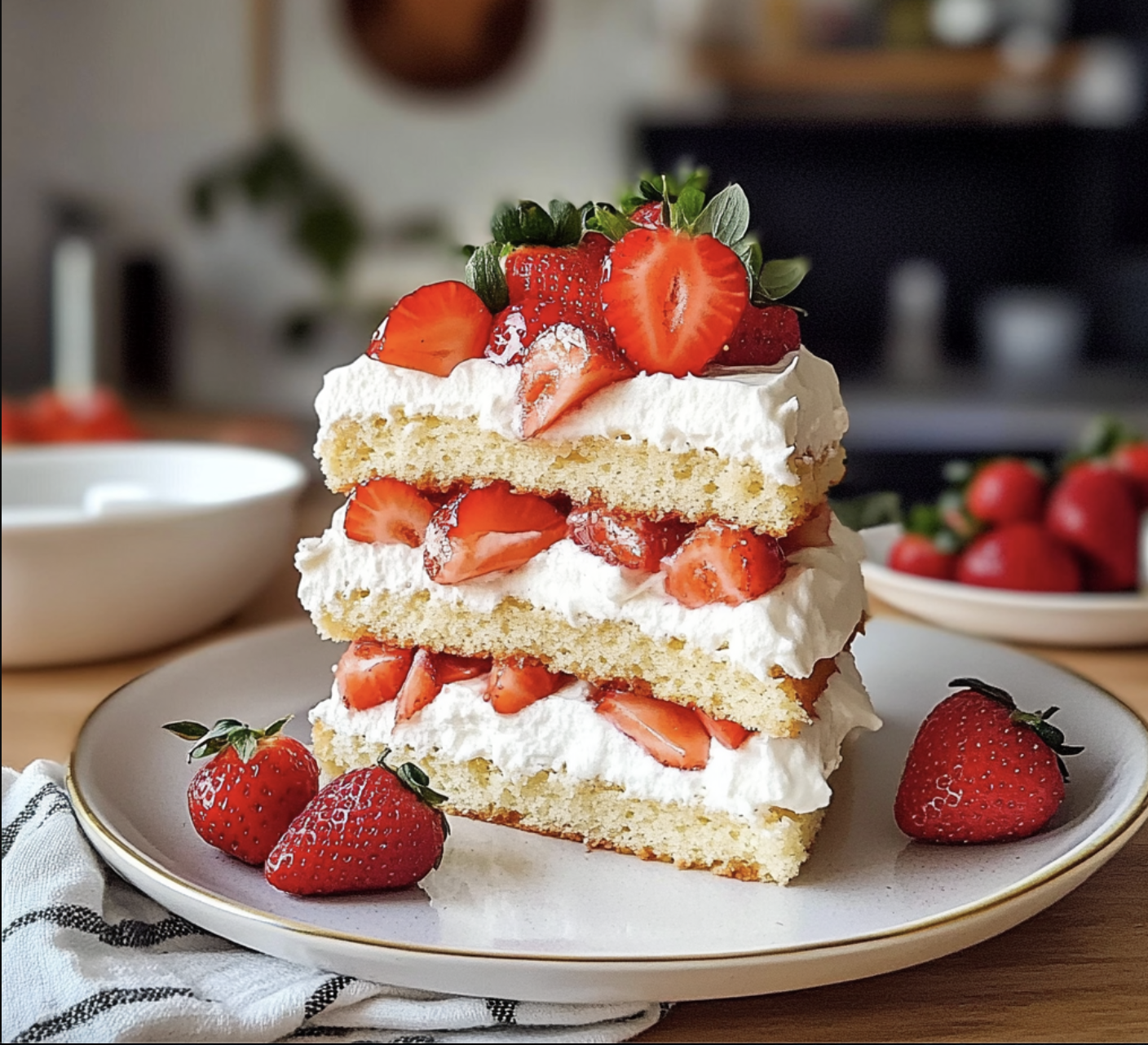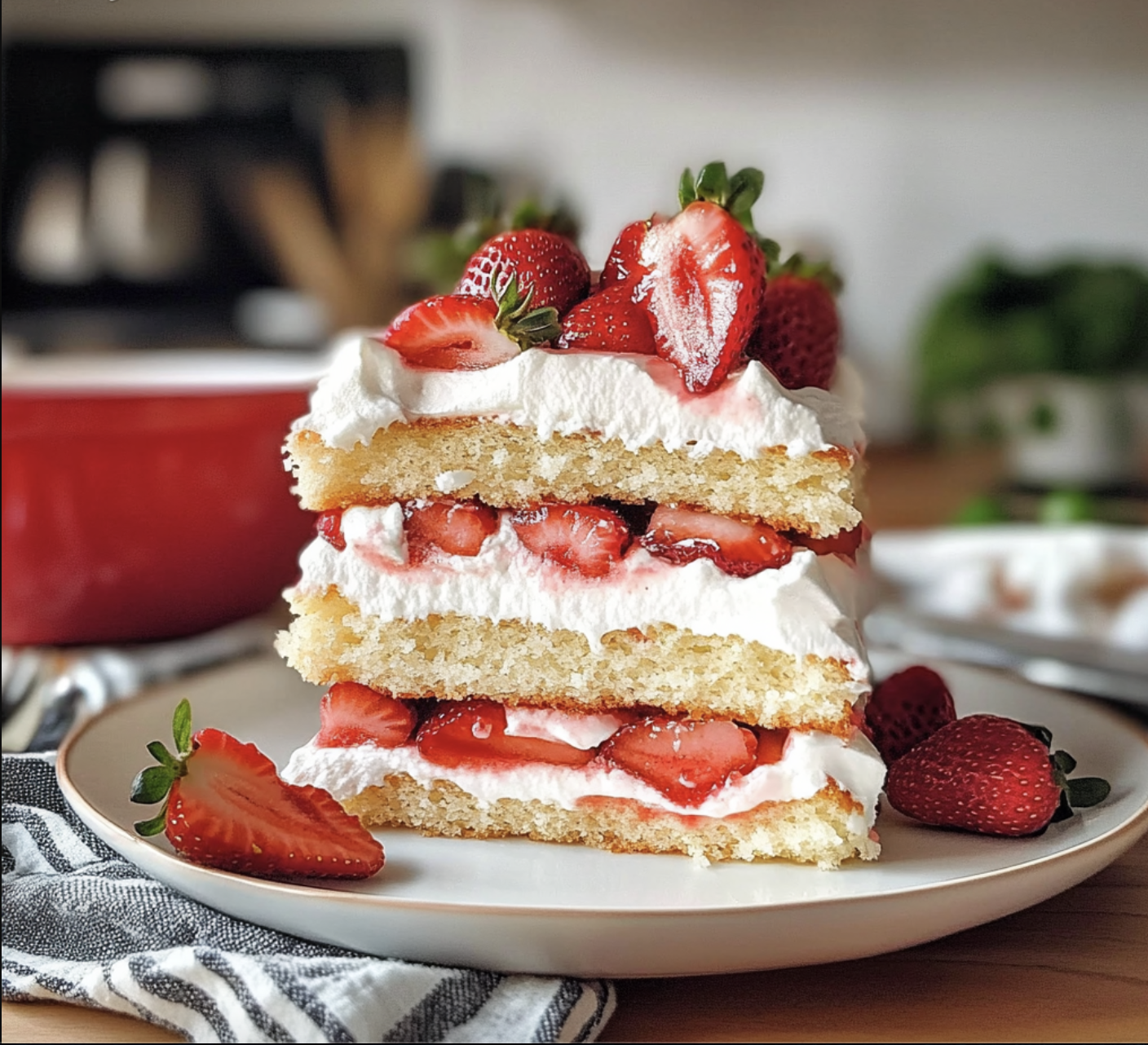 Bookmark
Bookmark
This strawberry shortcake cake transforms the classic summer dessert into an elegant layer cake that maintains all the charm of the original. Each bite delivers the perfect balance of tender cake, juicy berries, and cloud-like whipped cream.
I first made this cake for my daughter's spring birthday when she requested something "pretty and pink." Years later, it's still our family's most requested celebration cake, especially during strawberry season.
Ingredients
- All-purpose flour creates the perfect tender yet sturdy cake layers that can stand up to the moisture from the berries
- Baking powder provides just the right amount of lift for a light texture while maintaining structure
- Unsalted butter adds richness and allows you to control the salt level precisely
- Heavy cream in the cake batter creates an exceptionally moist crumb with a melt-in-your-mouth quality
- Fresh strawberries are essential use the ripest, most fragrant berries you can find for the best flavor
- Granulated sugar for macerating draws out the natural juices from the berries creating a luscious syrup
- Lemon juice brightens the strawberry flavor and balances the sweetness look for fresh lemons for best results
- Cold heavy whipping cream whips up into the perfect cloud-like frosting choose a high-fat content cream for best results
- Cream cheese optional but recommended for stability especially on warm days or for a cake that will sit out
Step-by-Step Instructions
- Macerate the Strawberries
- Hull and slice the fresh strawberries into even pieces about 1/4-inch thick. Toss them gently with granulated sugar and fresh lemon juice in a large bowl. Allow them to sit at room temperature for at least 30 minutes. During this time, the strawberries will release their juices creating a natural syrup that will flavor your cake.
- Prepare Your Pans
- Preheat your oven to 350°F. Properly prepare three 8-inch cake pans by greasing the bottoms and sides thoroughly. Cut parchment paper circles to fit the bottom of each pan this extra step ensures your cakes will release perfectly without sticking.
- Make the Shortcake Batter
- In a medium bowl, whisk together the flour, baking powder, and salt until evenly combined. In your stand mixer bowl, cream the butter and sugar on medium-high speed for 3-4 minutes until very light and fluffy scrape down the sides halfway through. Add eggs one at a time, beating well after each addition. Mix in the vanilla extract until incorporated. Reduce mixer speed to low and add the dry ingredients alternating with the heavy cream, beginning and ending with the dry ingredients. Mix just until combined be careful not to overmix which can make your cake tough.
- Bake the Cake Layers
- Divide the batter evenly between your prepared pans. Smooth the tops with an offset spatula. Bake for 20-25 minutes, rotating pans halfway through, until the cakes are golden and a toothpick inserted in the center comes out clean. Allow to cool in pans for 10 minutes before turning out onto cooling racks to cool completely.
- Prepare the Whipped Cream
- In a large chilled bowl, beat the cold heavy cream until it begins to thicken. Gradually add the powdered sugar and vanilla extract. If using cream cheese for stability, beat it separately until smooth, then gradually add to the cream mixture. Continue beating until medium-firm peaks form that will hold their shape but still look smooth and creamy.
- Assemble Your Masterpiece
- Place your first cake layer on a serving plate. Using a pastry brush, gently brush some of the strawberry syrup from the macerated berries over the cake. Spread a generous layer of whipped cream, leaving a small border around the edge. Arrange a layer of macerated strawberry slices over the cream. Top with the second cake layer and repeat the process. Add the final cake layer and cover the entire cake with the remaining whipped cream. Decorate the top with the most beautiful strawberry slices arranged in an attractive pattern.
 Bookmark
Bookmark
This cake reminds me of summers spent at my grandmother's farm where we would pick fresh strawberries in the morning and enjoy them in her shortcake by afternoon. The smell of fresh berries still transports me back to her kitchen, where I learned that the simplest ingredients often make the most memorable desserts.
Make-Ahead Tips
This cake can be partially prepared in advance to make assembly easier on the day you plan to serve it. The cake layers can be baked up to two days ahead, cooled completely, then wrapped tightly in plastic wrap and stored at room temperature. The strawberries should be macerated no more than 3-4 hours before assembly to maintain their texture while still developing that wonderful syrupy quality. For the whipped cream, adding the optional cream cheese will help it stay stable for longer periods, but I still recommend making it shortly before assembly for the freshest taste and texture.
Serving Suggestions
This strawberry shortcake cake shines when served with additional fresh berries on the side. For an extra special presentation, I like to create a small pitcher of the reserved strawberry macerating liquid to drizzle over each slice tableside. A small scoop of vanilla ice cream alongside each slice turns this into an even more decadent dessert experience. For a more casual approach, simply dust the top with a little extra powdered sugar just before bringing it to the table.
Seasonal Variations
While this cake is a summer classic with fresh strawberries, you can adapt it throughout the year with different berries or fruits. In late summer, try a mixed berry version with blackberries, blueberries and raspberries. In fall, thinly sliced poached pears make an elegant variation. Winter calls for a citrus version with supremed orange segments and a touch of orange zest in the whipped cream. The shortcake base remains the same throughout these seasonal adaptations, providing a versatile canvas for whatever fruits are at their peak.
Recipe FAQs
- → Can I make this strawberry shortcake cake ahead of time?
Yes, you can prepare components ahead of time. Bake the cake layers up to a day in advance and store them wrapped at room temperature. The strawberries can be macerated a few hours before assembly. However, the whipped cream and final assembly should be done within 4-6 hours of serving for best results. Once assembled, keep refrigerated until ready to serve.
- → Why add cream cheese to the whipped cream frosting?
Adding cream cheese to the whipped cream frosting provides stability, especially in warmer weather. It helps the frosting hold its shape longer without weeping or melting, while adding a subtle tangy flavor that complements the sweet strawberries. For a traditional whipped cream, you can omit it, but your cake may not hold up as well for extended periods.
- → Can I use frozen strawberries instead of fresh?
While fresh strawberries are ideal for their texture and appearance, frozen strawberries can work in a pinch. Thaw them completely and drain excess liquid before macerating. Note that frozen berries tend to be softer and release more juice, which might make your cake soggy. If using frozen berries, reduce the macerating time to 15 minutes.
- → How do I prevent my cake layers from becoming soggy?
To prevent soggy cake layers, make sure to drain the macerated strawberries well before placing them on the cake. The syrup can be brushed lightly on the cake layers, but don't oversaturate them. Additionally, if not serving immediately, you can create a barrier by spreading a thin layer of whipped cream on each cake layer before adding the strawberries.
- → What's the best way to slice strawberries for this cake?
For the most attractive presentation and even distribution, slice strawberries about ¼-inch thick. Remove the hulls first, then slice vertically from top to bottom. Reserve a few whole berries for decorating the top of the cake. Uniform slices will macerate evenly and create consistent layers within the cake.
- → Can I make this cake with other fruits?
Absolutely! While strawberries are traditional, this cake works beautifully with other berries like raspberries, blackberries, or blueberries. Peaches and nectarines are excellent summer alternatives. Just adjust the sugar in the macerating process based on the natural sweetness of the fruit you choose.
